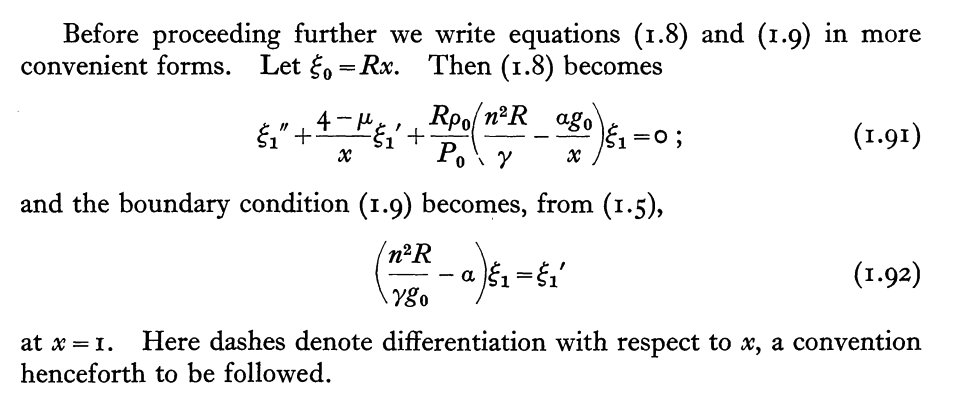User:Tohline/SSC/UniformDensity
Spherically Symmetric Configurations (Stability — Part III)

|
|---|
| | Tiled Menu | Tables of Content | Banner Video | Tohline Home Page | |
Suppose we now want to study the stability of one of the spherically symmetric, equilibrium structures that have been derived elsewhere. The identified set of simplified, time-dependent governing equations will tell us how the configuration will respond to an applied radial (i.e., spherically symmetric) perturbation that pushes the configuration slightly away from its initial equilibrium state.
The Eigenvalue Problem
As has been derived in an accompanying discussion, the second-order ODE that defines the relevant Eigenvalue problem is,
<math>
\frac{d^2x}{d\chi_0^2} + \biggl[\frac{4}{\chi_0} - \biggl(\frac{\rho_0}{\rho_c}\biggr) \biggl(\frac{P_0}{P_c}\biggr)^{-1} \biggl(\frac{g_0}{g_\mathrm{SSC}}\biggr) \biggr] \frac{dx}{d\chi_0} + \biggl(\frac{\rho_0}{\rho_c}\biggr) \biggl(\frac{P_0}{P_c}\biggr)^{-1} \biggl(\frac{1}{\gamma_\mathrm{g}} \biggr)\biggl[\tau_\mathrm{SSC}^2 \omega^2 + (4 - 3\gamma_\mathrm{g})\biggl(\frac{g_0}{g_\mathrm{SSC}}\biggr) \frac{1}{\chi_0} \biggr] x = 0 .
</math>
where the dimensionless radius,
<math>
\chi_0 \equiv \frac{r_0}{R} ,
</math>
the characteristic time for dynamical oscillations in spherically symmetric configurations (SSC) is,
<math>
\tau_\mathrm{SSC} \equiv \biggl[ \frac{R^2 \rho_c}{P_c} \biggr]^{1/2} ,
</math>
and the characteristic gravitational acceleration is,
<math>
g_\mathrm{SSC} \equiv \frac{P_c}{R \rho_c} .
</math>
Uniform-Density Configuration
Sterne (1937)
T. E. Sterne (1937) begins his analysis by deriving the
Adiabatic Wave (or Radial Pulsation) Equation
|
<math>~ \frac{d^2x}{dr_0^2} + \biggl[\frac{4}{r_0} - \biggl(\frac{g_0 \rho_0}{P_0}\biggr) \biggr] \frac{dx}{dr_0} + \biggl(\frac{\rho_0}{\gamma_\mathrm{g} P_0} \biggr)\biggl[\omega^2 + (4 - 3\gamma_\mathrm{g})\frac{g_0}{r_0} \biggr] x = 0 </math> |
in a manner explicitly designed to reproduce Eddington's pulsation equation — it appears as equation (1.8) in Sterne's paper — and, along with it, the surface boundary condition,
|
<math>~ r_0 \frac{d\ln x}{dr_0}</math> |
<math>~=</math> |
<math>~\frac{1}{\gamma_g} \biggl( 4 - 3\gamma_g + \frac{\omega^2 R^3}{GM_\mathrm{tot}}\biggr) </math> at <math>~r_0 = R \, ,</math> |
which appears in Sterne's paper as equation (1.9). Then, as shown in the following paragraph extracted directly from his paper, Sterne (1937) rewrites both of these expressions in, what he considers to be, "more convenient forms."
|
Paragraph extracted from T. E. Sterne (1937)
"Modes of Radial Oscillation"
Monthly Notices of the Royal Astronomical Society, vol. 97, pp. 582 - © Royal Astronomical Society |
|||||||||||||||
|---|---|---|---|---|---|---|---|---|---|---|---|---|---|---|---|
| |||||||||||||||
Correspondence with our derived equation becomes clear by appreciating that Christy's <math>~x \equiv r_0/R</math> and that,
<math>GM(x) = g_0 r_0^2 \, ,</math>
hence,
<math>V(x) \rightarrow \frac{g_0 \rho_0 r_0}{P_0} \, .</math>
Setup
From our derived structure of a uniform-density sphere, in terms of the configuration's radius <math>R</math> and mass <math>M</math>, the central pressure and density are, respectively,
<math>P_c = \frac{3G}{8\pi}\biggl( \frac{M^2}{R^4} \biggr) </math> ,
and
<math>\rho_c = \frac{3M}{4\pi R^3} </math> .
Hence the characteristic time and acceleration are, respectively,
<math>
\tau_\mathrm{SSC} = \biggl[ \frac{R^2 \rho_c}{P_c} \biggr]^{1/2} =
\biggl[ \frac{2R^3 }{GM} \biggr]^{1/2} =
\biggl[ \frac{3}{2\pi G\rho_c} \biggr]^{1/2},
</math>
and,
<math>
g_\mathrm{SSC} = \frac{P_c}{R \rho_c} = \biggl( \frac{GM}{2R^2} \biggr) .
</math>
The required functions are,
- Density:
<math>\frac{\rho_0(r_0)}{\rho_c} = 1 </math> ;
- Pressure:
<math>\frac{P_0(r_0)}{P_c} = 1 - \chi_0^2 </math> ;
- Gravitational acceleration:
<math>
\frac{g_0(r_0)}{g_\mathrm{SSC}} = 2\chi_0 .
</math>
So our desired Eigenvalues and Eigenvectors will be solutions to the following ODE:
<math>
\frac{1}{(1 - \chi_0^2)} \biggl\{ (1 - \chi_0^2) \frac{d^2x}{d\chi_0^2} + \frac{4}{\chi_0}\biggl[1 - \frac{3}{2}\chi_0^2 \biggr] \frac{dx}{d\chi_0} + \frac{1}{\gamma_\mathrm{g}} \biggl[\tau_\mathrm{SSC}^2 \omega^2 + 2 (4 - 3\gamma_\mathrm{g}) \biggr] x \biggr\} = 0 .
</math>
First few lowest-order modes
- Mode 0:
- <math>x_0 = \mathrm{constant}</math>, in which case,
<math> \omega_0^2 = - 2(4 - 3\gamma_\mathrm{g})\biggl[ \frac{2\pi G\rho_c}{3} \biggr] = 4\pi G \rho_c \biggl[ \gamma_\mathrm{g}- \frac{4}{3} \biggr] </math>
- Mode 1:
- <math>x_1 = a + b\chi_0^2</math>, in which case,
<math> \frac{dx}{d\chi_0} = 2b\chi_0; ~~~~ \frac{d^2 x}{d\chi_0^2} = 2b; </math>
<math>
\frac{1}{(1 - \chi_0^2)} \biggl\{ 2b (1 - \chi_0^2) + 8b \biggl[1 - \frac{3}{2}\chi_0^2 \biggr] + A_1 \biggl(1 + \frac{b}{a}\chi_0^2 \biggr) \biggr\} = 0 ,
</math>
where,
<math> A_1 \equiv \frac{a}{\gamma_\mathrm{g}}\biggl[ \biggl( \frac{3}{2\pi G\rho_c} \biggr) \omega_1^2+ 2(4 - 3\gamma_\mathrm{g}) \biggr] . </math>
Therefore,
<math>
(A_1 + 10b) + \biggl[ \biggl(\frac{b}{a}\biggr) A_1 - 14b \biggr] \chi_0^2 = 0 ,
</math>
<math>
\Rightarrow ~~~~~ A_1 = - 10b ~~~~~\mathrm{and} ~~~~~ A_1 = 14a
</math>
<math>
\Rightarrow ~~~~~ \frac{b}{a} = -\frac{7}{5} ~~~~~\mathrm{and} ~~~~~ \frac{A_1}{a} = 14 = \frac{1}{\gamma_\mathrm{g}}\biggl[ \biggl( \frac{3}{2\pi G\rho_c} \biggr) \omega_1^2+ 2(4 - 3\gamma_\mathrm{g}) \biggr] .
</math>
Hence,
<math>
\biggl( \frac{3}{2\pi G\rho_c} \biggr) \omega_1^2 = 20\gamma_\mathrm{g} -8
</math>
<math>
\Rightarrow ~~~~~ \omega_1^2 = \frac{2}{3}\biggl( 4\pi G\rho_c \biggr) (5\gamma_\mathrm{g} -2)
</math>
and, to within an arbitrary normalization factor,
<math> x_1 = 1 - \frac{7}{5}\chi_0^2 . </math>
n=1 Polytrope
This discussion has been moved to another chapter.

|
|---|
|
© 2014 - 2021 by Joel E. Tohline |

